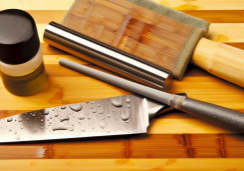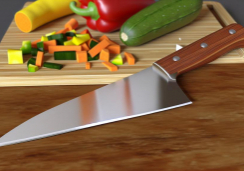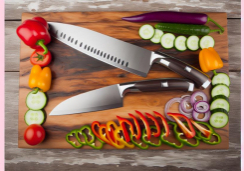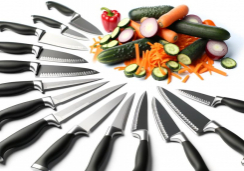Mastering High-Carbon Steel Knife Maintenance: A How-To Guide
Just as you reach for your favorite high-carbon steel knife, it hits you: the once mirror-like blade now bears the tell-tale smudges of corrosion, a stark reminder that even the finest tools demand respect and routine care.
You've invested in quality, and it's clear that maintaining the keen edge and pristine condition of your knife requires knowledge and a touch of finesse. In this guide, you'll learn the essential daily cleaning rituals, the art of sharpening, and the secrets to preventing rust that can compromise your blade's integrity.
As you explore the intricacies of proper storage solutions, consider how these practices will not only prolong the life of your knife but also enhance your culinary precision. What you may not realize is how these techniques can also reveal a deeper appreciation for your craft, beckoning you to uncover the subtle balance between utility and care.
Understanding High-Carbon Steel
High-carbon steel, characterized by its superior hardness and strength, is the preferred material for knives that demand sharp, durable edges. When you're selecting a knife for precision cutting, you're not just choosing a tool; you're investing in an alloy designed for peak performance.
High-carbon steel blades contain a carbon content typically between 0.6% and 1.7%, which directly contributes to the steel's hardness. This increased hardness enables the blade to maintain a sharper edge for longer periods, resisting wear and tear from regular use.
However, it's crucial to recognize that high-carbon steel is also more susceptible to corrosion and rust if not properly maintained. It lacks the chromium content found in stainless steel that offers resistance to such issues. To ensure your knife's longevity, you must adhere to a strict care regimen, which includes regular cleaning, drying, and oiling of the blade to protect it from moisture and acidic materials.
Understanding the properties of high-carbon steel is fundamental to maintaining its edge and preventing deterioration. With your knowledge of its composition and vulnerabilities, you're equipped to provide the necessary care. Proper maintenance not only extends the life of your knife but also guarantees that it remains a reliable extension of your own skillful hand.
Daily Cleaning Procedures
To maintain the integrity of your knife's edge, begin each day with a thorough cleaning of the blade, using a mild detergent and warm water to remove any accumulated debris or residues. It's crucial to apply the detergent with a soft sponge or cloth, ensuring you're not scratching the blade's surface. Scrub gently along the blade's grain, not against it, to preserve the metal's integrity.
After washing, rinse the knife immediately with clean water to prevent any detergent from settling onto the steel, which could cause corrosion over time. You'll want to dry the knife completely with a soft, lint-free towel to avoid water spots and potential rusting. Don't let it air dry, as prolonged exposure to moisture is detrimental to high-carbon steel.
Once dry, store your knife in a dry, safe place. A magnetic strip or a slotted knife block are preferable storage methods that prevent unnecessary contact with other utensils, which could dull the blade. Steer clear of tossing your knife into a drawer without a protective sleeve—this can lead to nicks and corrosion.
Sharpening Techniques
Regularly sharpening your knife ensures optimal performance and extends its lifespan, so it's essential to master the correct techniques.
For high-carbon steel knives, you'll need to maintain a precise angle between the blade and the sharpening stone—typically between 15 to 20 degrees. Use a whetstone with a grit suitable for the knife's condition; start with a coarse grit to reshape the edge if it's particularly dull, then move to a finer grit for honing.
Firstly, soak your whetstone in water until it's saturated, which may take up to 10 minutes. Place the stone on a stable surface. Hold the knife with a firm grip, placing your fingers on the blade's flat side away from the edge. Glide the knife across the stone in smooth, controlled strokes, maintaining the angle consistently. Alternate sides to sharpen evenly.
After several passes on the coarser stone, switch to the finer grit. This will polish the edge and remove any burrs, leaving it razor-sharp.
Finally, test the sharpness on a piece of paper; a well-sharpened knife should slice through effortlessly.
With these steps, you'll maintain a sharp, durable edge on your high-carbon steel knife.
Preventing Rust and Corrosion
Maintaining your knife's resistance to rust and corrosion is as crucial as keeping its edge sharp, especially since moisture and environmental factors can quickly degrade the quality of the steel. To ensure your high-carbon steel knife remains in pristine condition, adhere to the following preventative measures:
- Keep It Dry: Always wipe your knife with a clean cloth immediately after use. Even minimal exposure to water can initiate oxidation, so it's essential to remove any moisture before storage. If you've used your knife with acidic substances, rinse it with mild soapy water and dry it thoroughly.
- Oil the Blade: Apply a thin coat of a food-grade mineral oil to the blade after cleaning. This creates a barrier against moisture and pollutants. Be meticulous in covering the entirety of the blade, including the edge and spine.
- Store Properly: When not in use, store your knife in a dry environment. A knife block, sheath, or a specially designed storage case with desiccant packets can provide added protection. Avoid storing your knife in a leather sheath for long periods, as leather can attract moisture and cause corrosion.
Adhering to these steps will significantly enhance the longevity of your high-carbon steel knife, ensuring it remains corrosion-free and ready for your next culinary adventure or outdoor pursuit.
Proper Storage Solutions
Having covered the vital steps to prevent rust and corrosion, let's now focus on the proper storage solutions that will further safeguard your knife's integrity and sharpness.
You must store your high-carbon steel knife in a dry, controlled environment. A common mistake is tossing it into a kitchen drawer, where it can knock against other utensils, leading to nicks and dullness.
Instead, opt for a knife block or magnetic strip. These storage methods prevent blade-to-blade contact, maintaining your knife's edge. Ensure the knife block is made of a soft, non-abrasive material like wood to avoid microscopic damage to the blade. If you prefer a magnetic strip, ensure it's coated to provide a cushion between the magnet and your knife's surface.
For those who value mobility, a knife roll or sheath offers excellent protection. Choose materials that are breathable yet shield your blade from moisture – oil-tanned leather or waxed canvas are ideal. Avoid synthetic sheaths that trap humidity, as they can induce rust formation.
Can High-Carbon Steel Knives Be Included in a Multipurpose Knife Set?
High-carbon steel knives can definitely be included in the best multipurpose knife sets. Known for their durability and ability to hold a sharp edge, high-carbon steel knives are perfect for various cutting tasks. Whether it’s slicing, dicing, or chopping, these knives are a valuable addition to any kitchen set.
Conclusion
In conclusion, you've learned that maintaining your high-carbon steel knives requires diligence. Clean them daily, hone their edges regularly, and stave off rust with preventive measures.
Store your blades in a moisture-free environment to ensure their longevity. With these technical steps, you'll keep your knives in peak condition, ready to tackle any culinary challenge.
Remember, meticulous care is the key to preserving the superior performance of your high-carbon steel cutlery.








